Using Graphene-Based Grease as a Heat Conduction Material for Hectowatt-Level LEDs: A Natural Convection Experiment
Abstract
1. Introduction
2. Single-Chip and Chip-on-Board LEDs
3. Graphene Powder and Graphene Thermal Grease
4. Thermal FE-SEM Images for Graphene Compositions
- (1)
- The graphene thermal grease was coated on a metal surface such as copper, aluminum, or stainless steel. As the temperature of the thermal FE-SEM scanning was between 150 °C and 180 °C, a metal material could be used as the test sample coating substrate.
- (2)
- The graphene thermal grease was applied on the surface of the test metal sample and baked until it was dry, oil-free, and water-free to avoid damaging the thermal FE-SEM lens equipment due to excessive oil and water evaporation.
- (3)
- The test example was placed in a platinum coating machine, and vacuum operation was started (10−3 torr). The upper cover of the machine was filled with a minute quantity (<0.01 g) of platinum powder. During the vacuum process, the platinum powder was naturally sprayed on the test example. After being in vacuum for 30 to 40 min, the platinum coating machine ceased operation, and the test sample was taken to the FE-SEM machine for SEM analysis to display the results of FE-SEM and so that the microstructure could be clearly seen.
- (4)
- The samples of coated graphene grease were placed under the electron microscope to observe their composition and structure and examine the possible average thickness of the material at a microscale.
5. Experimental Research Process and Procedure
6. Thermal Experimental Equipment
7. Results and Discussion
7.1. Natural Convection Control Chamber for Chip-on-Board LEDs
7.2. Temperature Measurement of Various Concentrations of Graphene Grease
7.3. Flow Visualization
7.4. Thermal Image Temperature Distribution
7.5. Discussion
8. Conclusions
Author Contributions
Funding
Institutional Review Board Statement
Informed Consent Statement
Data Availability Statement
Acknowledgments
Conflicts of Interest
References
- Bidsorkhi, H.C.; D’Aloia, A.G.; Tamburrano, A.; De Bellis, G.; Delfini, A.; Ballirano, P.; Sarto, M.S. 3D Porous Graphene Based Aerogel for Electromagnetic Applications. Sci. Rep. 2019, 9, 15719. [Google Scholar] [CrossRef] [PubMed]
- Liang, W.; Ge, X.; Ge, J.; Li, T.; Zhao, T.; Chen, X.; Zhang, M.; Ji, J.; Pang, X.; Liu, R. Three-dimensional Heterostructured Reduced Graphene Oxide-Hexagonal Boron Nitride-Stacking Material for Silicone Thermal Grease with Enhanced Thermally Conductive Properties. Nanomaterials 2019, 9, 938. [Google Scholar] [CrossRef] [PubMed]
- Mohamed, A.; Tirth, V.; Kamel, B.M. Tribological characterization and rheology of hybrid calcium grease with graphene nanosheets and multi-walled carbon nanotubes as additives. J. Mater. Res. Technol. 2020, 9, 6178–6185. [Google Scholar] [CrossRef]
- Naghibi, S.; Kargar, F.; Wright, D.; Huang, C.Y.T.; Mohammadzadeh, A.; Barani, Z.; Salgado, R.; Balandin, A.A. Noncuring Graphene Thermal Interface Materials for Advanced Electronics. Adv. Electron. Mater. 2020, 1–9. [Google Scholar] [CrossRef]
- Phuong, M.T.; Trinh, P.V.; Dinh, N.N.; Minh, P.N.; Dung, N.D.; Thang, B.H. Effect of Graphene Nanoplatelet Concentration on the Thermal Conductivity of Silicone Thermal Grease. J. Nano Electron. Phys. 2019, 11, 05039. [Google Scholar] [CrossRef]
- Yu, W.; Xie, H.; Chen, L.; Zhu, Z.; Zhao, J.; Zhang, Z. Graphene based silicone thermal greases. Phys. Lett. A 2014, 378, 207–211. [Google Scholar] [CrossRef]
- Junaid, M.; Khir, M.H.M.; Witjaksono, G.; Ullah, Z.; Tansu, N.; Saheed, M.S.M.; Kumar, P.; Wah, L.H.; Magsi, S.A.; Siddiqui, M.A. A Review on Graphene-Based Light Emitting Functional Devices. Molecules 2020, 25, 4217. [Google Scholar] [CrossRef] [PubMed]
- Chang, C.Y.; Lu, T.C. Application of Graphene in Light Emitting Diodes. Electron. Mon. 2013, 19, 90–99. Available online: https://engineer.windeal.com.tw/supware/temp/i439_elene_0220_90.pdf (accessed on 15 November 2020).
- Hsiao, T.J.; Eyassu, T.; Henderson, K.; Kim, T.; Lin, C.T. Monolayer Graphene Dispersion and Radiative Cooling for High Power LED. Nanotechnology 2013, 24, 395401. [Google Scholar] [CrossRef] [PubMed]
- Kim, B.J.; Mastro, M.A.; Hite, J.; Eddy, C.R.; Kim, J. Transparent Conductive Graphene Electrode in GaN-based Ultra-violet Light Emitting Diodes. Opt. Express 2010, 18, 23030–23034. [Google Scholar] [CrossRef] [PubMed]
- Kang, J.; Li, Z.; Li, H.; Liu, Z.; Li, X.; Yi, X.; Ma, P.; Zhu, H.; Wang, G. Pyramid Array InGaN/GaN Core-shell Light Emitting Diodes with Homogeneous Multilayer Graphene Electrodes. Appl. Phys. Express 2013, 6, 072102. [Google Scholar] [CrossRef]
- Yin, L.; Nan, T.; He, P.; Chen, Z.; Yang, L.Q.; Zhang, J. Thermal Performance Enhancement of Light Emitting Diode Device with Multilayer-Graphene Transferred to the Substrate Surface. ECS J. Solid State Sci. Technol. 2017, 6, 35–39. [Google Scholar] [CrossRef]
- Lay, K.K.; Cheong, B.M.Y.; Tong, W.L.; Tan, M.K.; Hung, Y.M. Effective Micro-spray Cooling for Light-emitting Diode with Graphene Nanoporous Layers. Nanotechnology 2017, 28, 164003. [Google Scholar] [CrossRef] [PubMed]
- Kim, C.M.; Kang, Y.T. Cooling Performance Enhancement of LED (Light Emitting Diode) Using Nano-pastes for Energy Conversion Application. Energy 2014, 76, 468–476. [Google Scholar] [CrossRef]
- Colaco, A.M.; Kurian, C.P.; Kini, S.G.; Colaco, S.G.; Johny, C. Thermal Characterization of Multicolor LED Luminaire. Microelectron. Reliab. 2017, 78, 379–388. [Google Scholar] [CrossRef]
- Kim, J.; Yim, B.S.; Kim, J.M.; Kim, J.H. The Effects of Functionalized Graphene Nanosheets on the Thermal and Mechanical Properties of Epoxy Composites for Anisotropic Conductive Adhesives (ACAs). Microelectron. Reliab. 2012, 52, 595–602. [Google Scholar] [CrossRef]
- Ding, W.T. The Thermal Spreading Resistance Effects Analysis of LEDs. Master’s Thesis, National Chiao Tung University, Hsinchu City, Taiwan, 2014. [Google Scholar]
- Lin, Y.; Lu, Y.; Gao, Y.; Chen, Y.L.; Chen, Z. Measuring the Thermal Resistance of LED Packages in Practical Circumstances. Thermochim. Acta 2011, 520, 105–109. [Google Scholar] [CrossRef]
- Wang, M.; Tao, H.H.; Sun, Z.H.; Zhang, C.G. The Development and Performance of the High-power LED Radiator. Int. J. Therm. Sci. 2017, 113, 65–72. [Google Scholar] [CrossRef]
- Janicki, M.; Torzewicz, T.; Samson, A.; Raszkowski, T.; Napieralski, A.K.T. Experimental Identification of LED Compact Thermal Model Element Values. Microelectron. Reliab. 2018, 86, 20–26. [Google Scholar] [CrossRef]
- Kang, H.; Kim, H.; An, J.; Choi, S.; Yang, J.; Jeong, H.; Huh, S. Thermal Conductivity Characterization of Thermal Grease Containing Copper Nanopowder. Materials 2020, 13, 1893. [Google Scholar] [CrossRef] [PubMed]


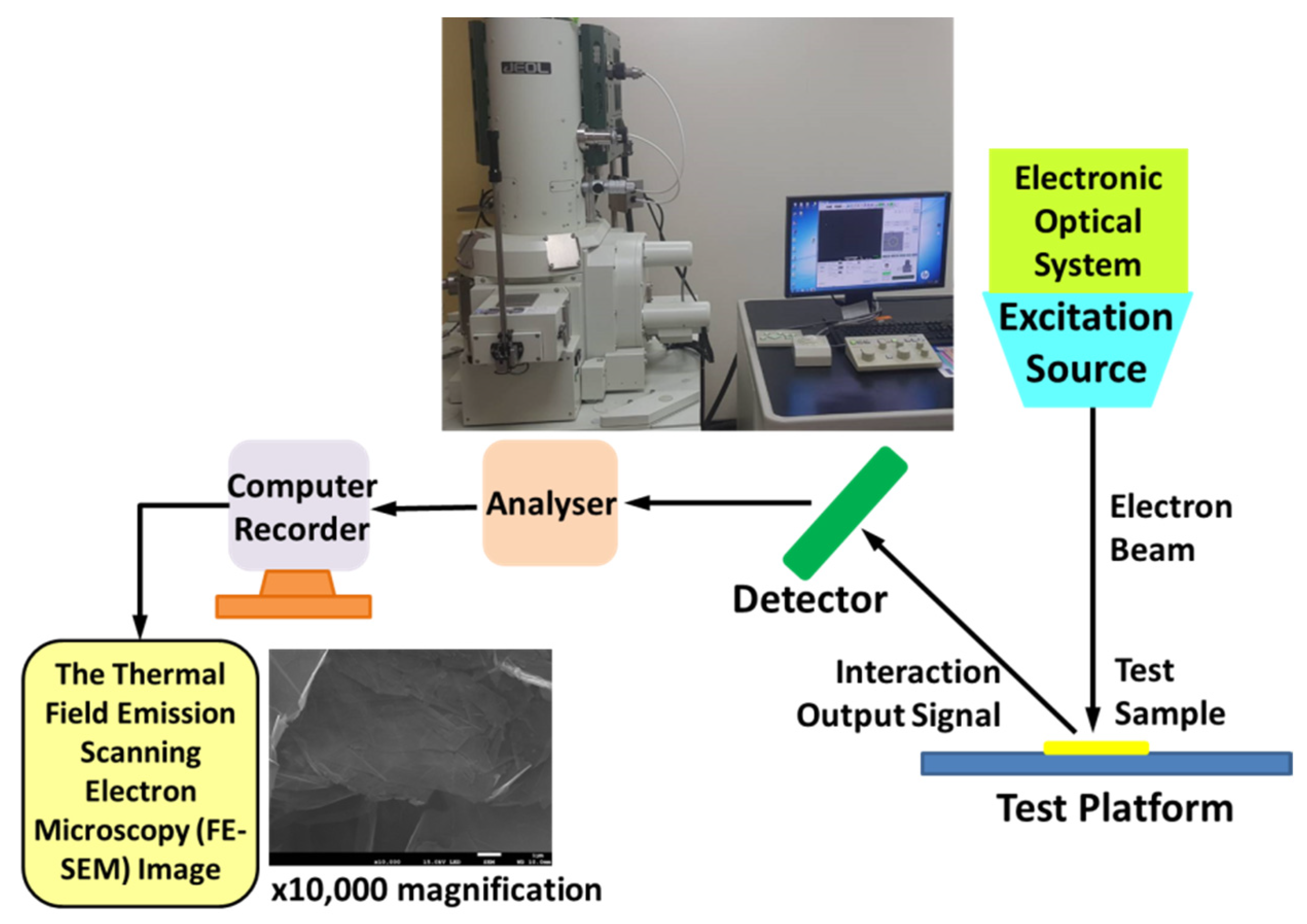
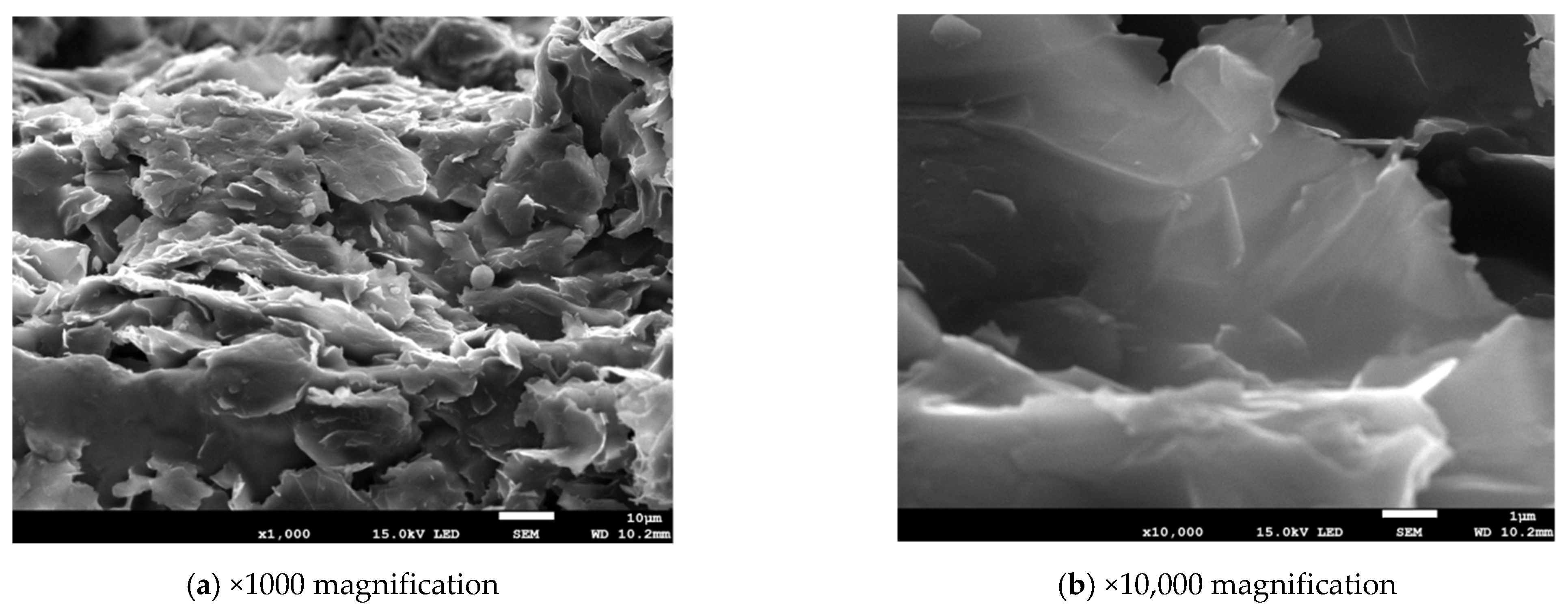



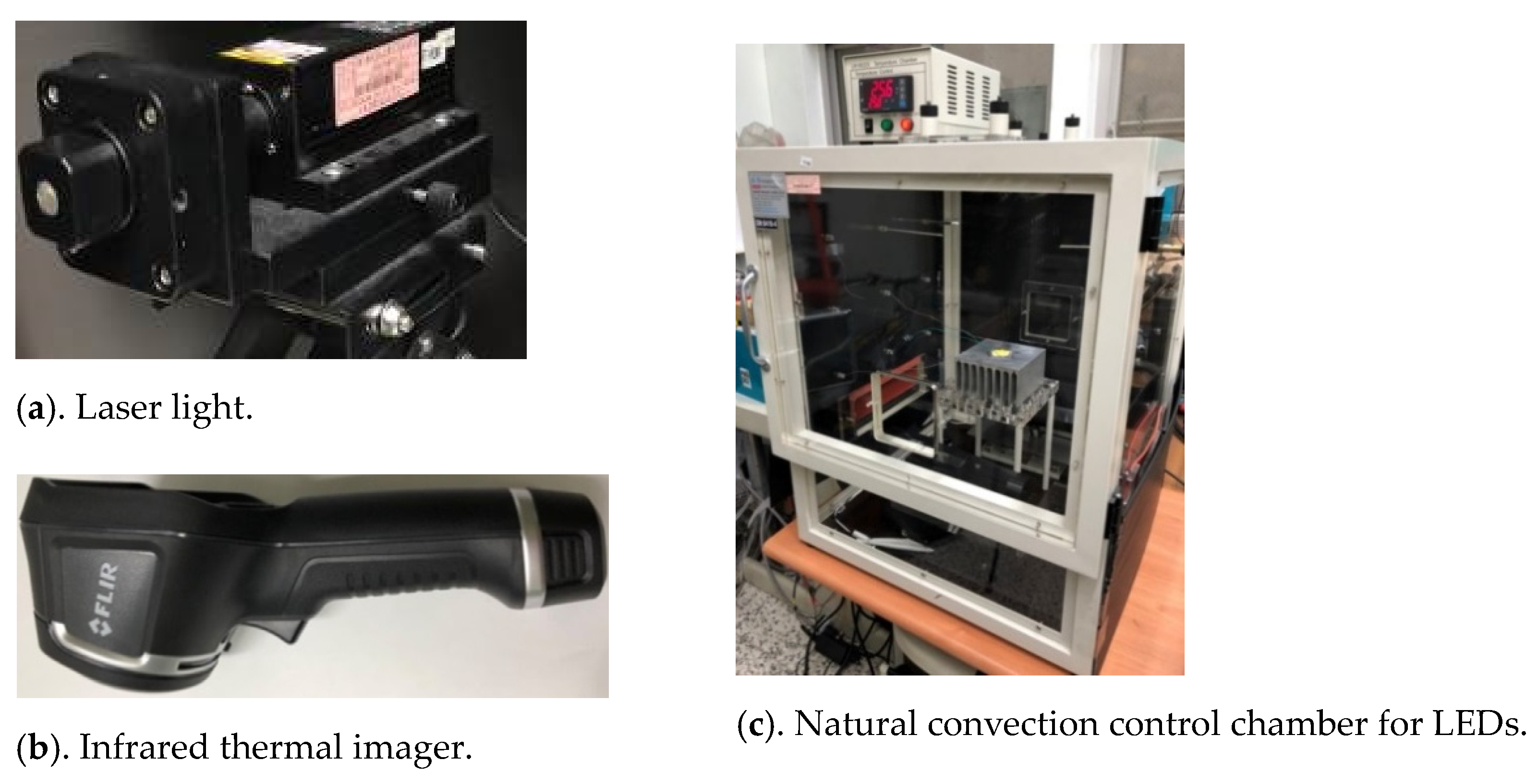

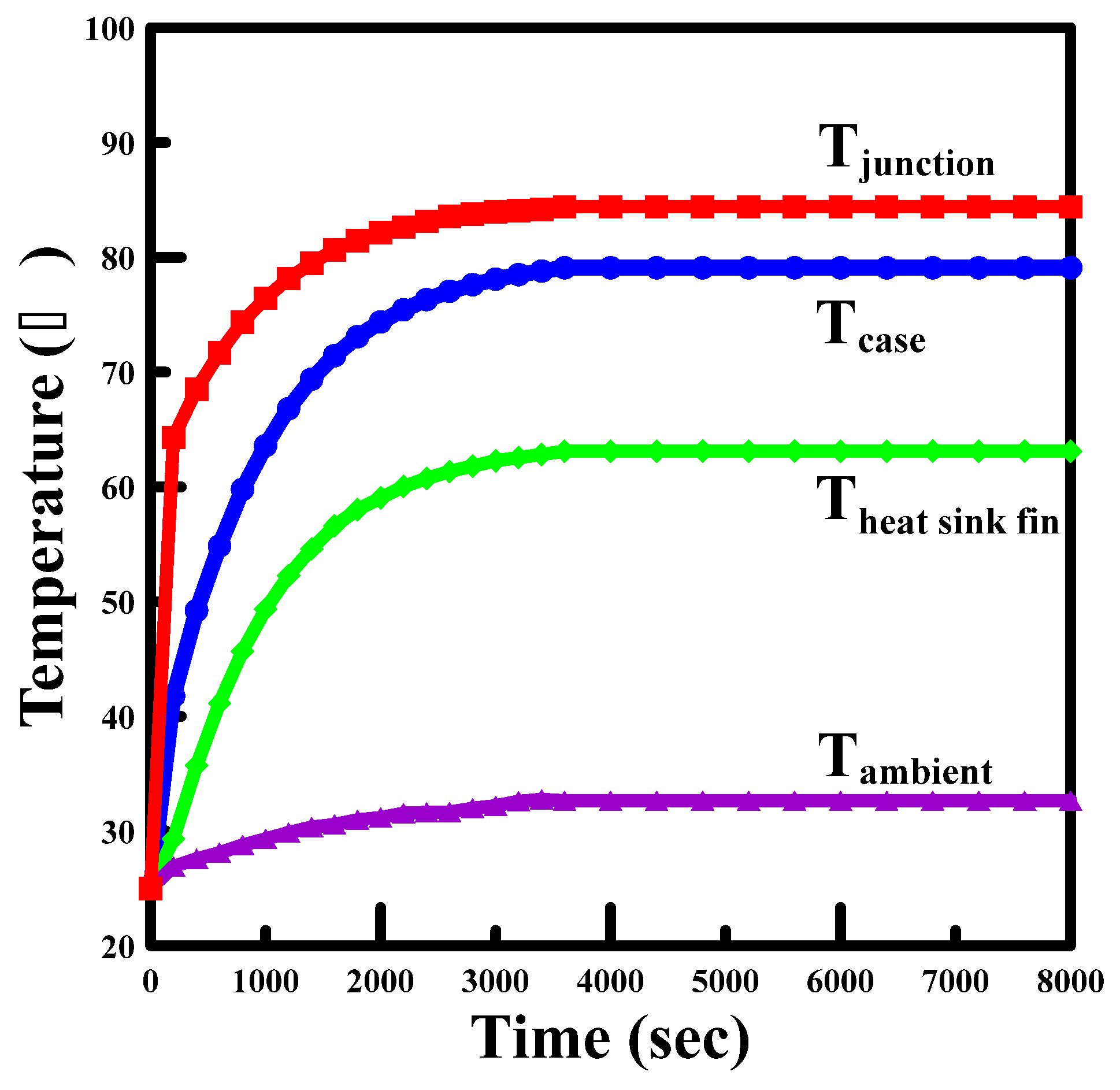
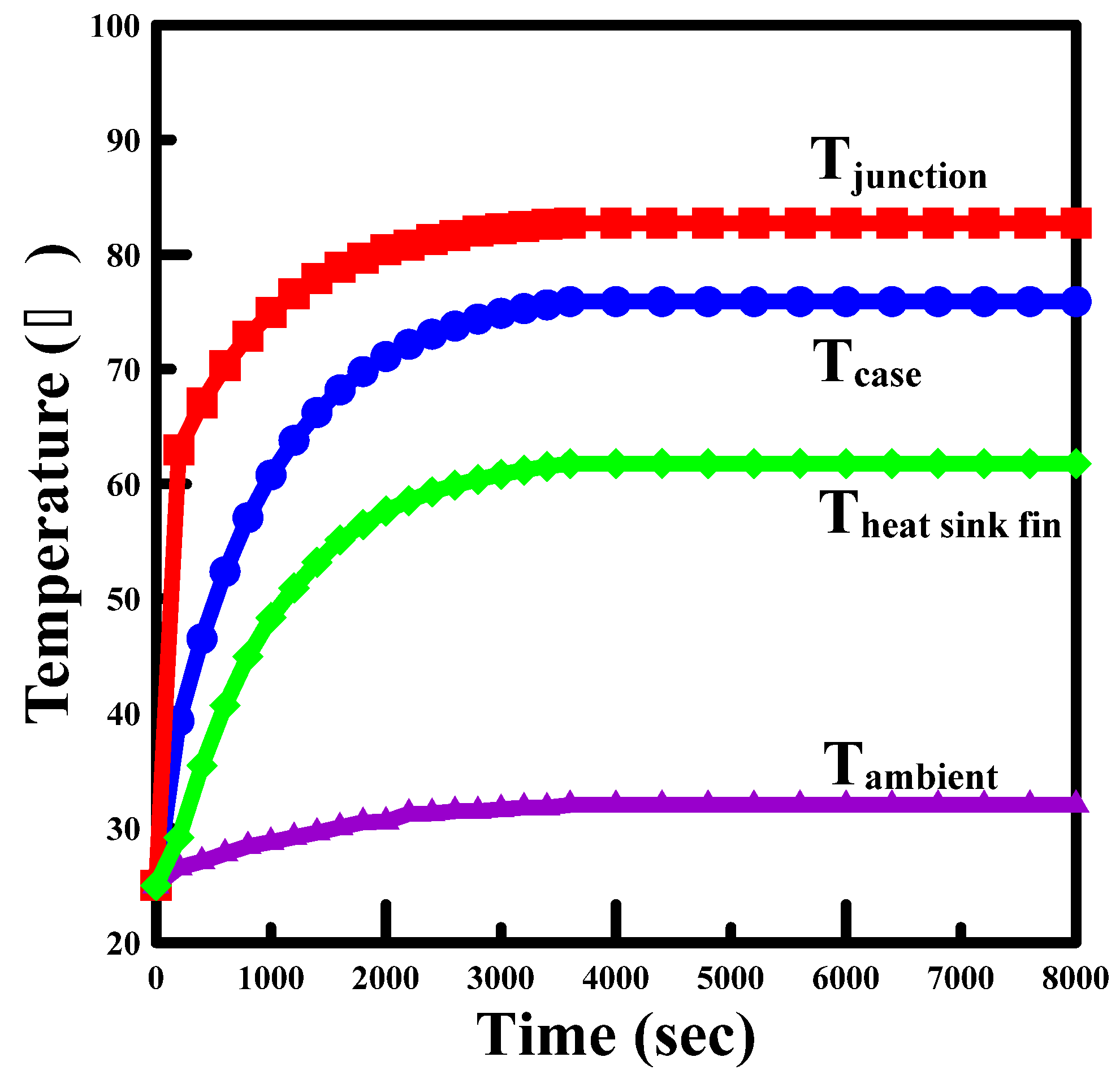
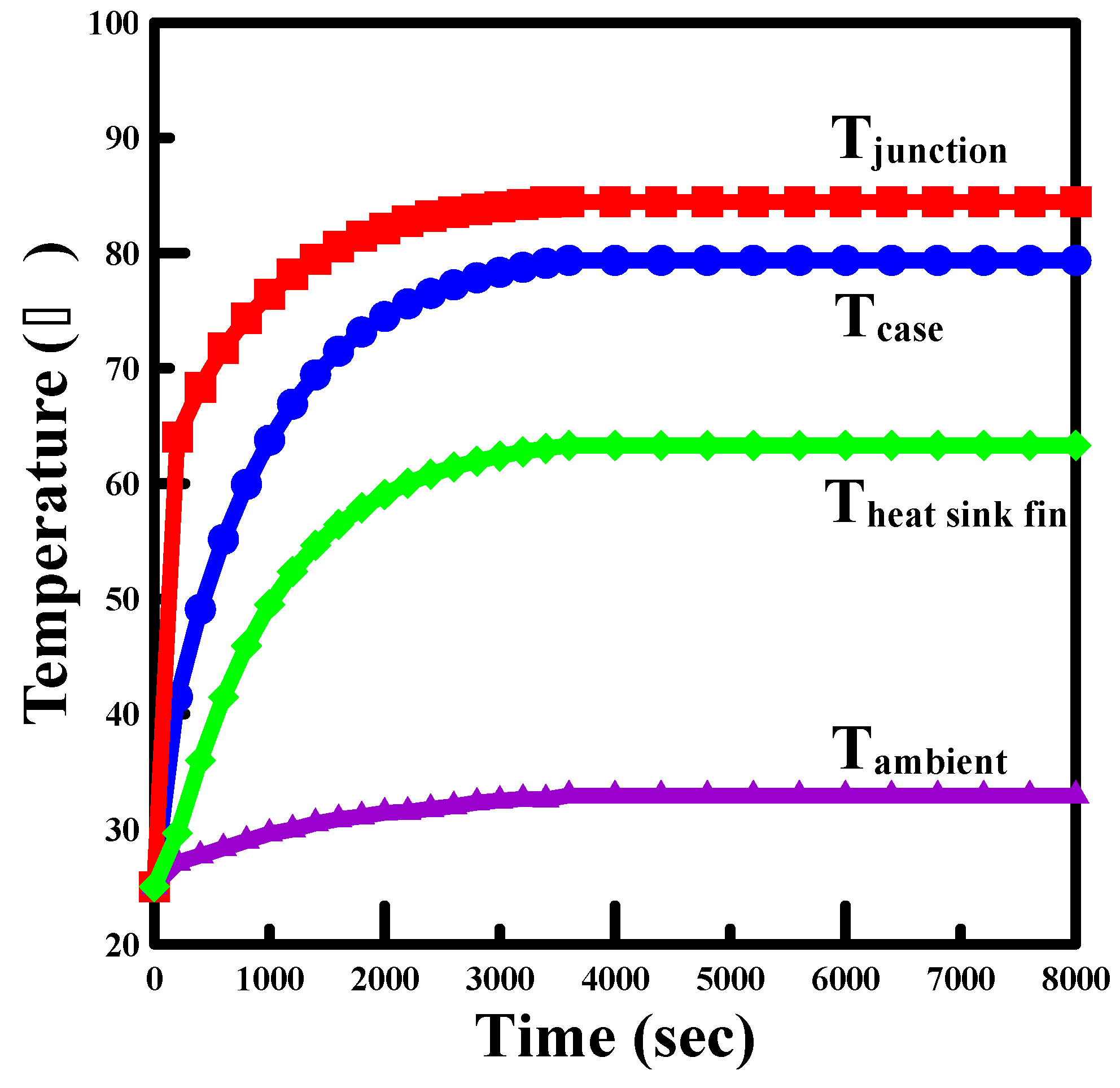
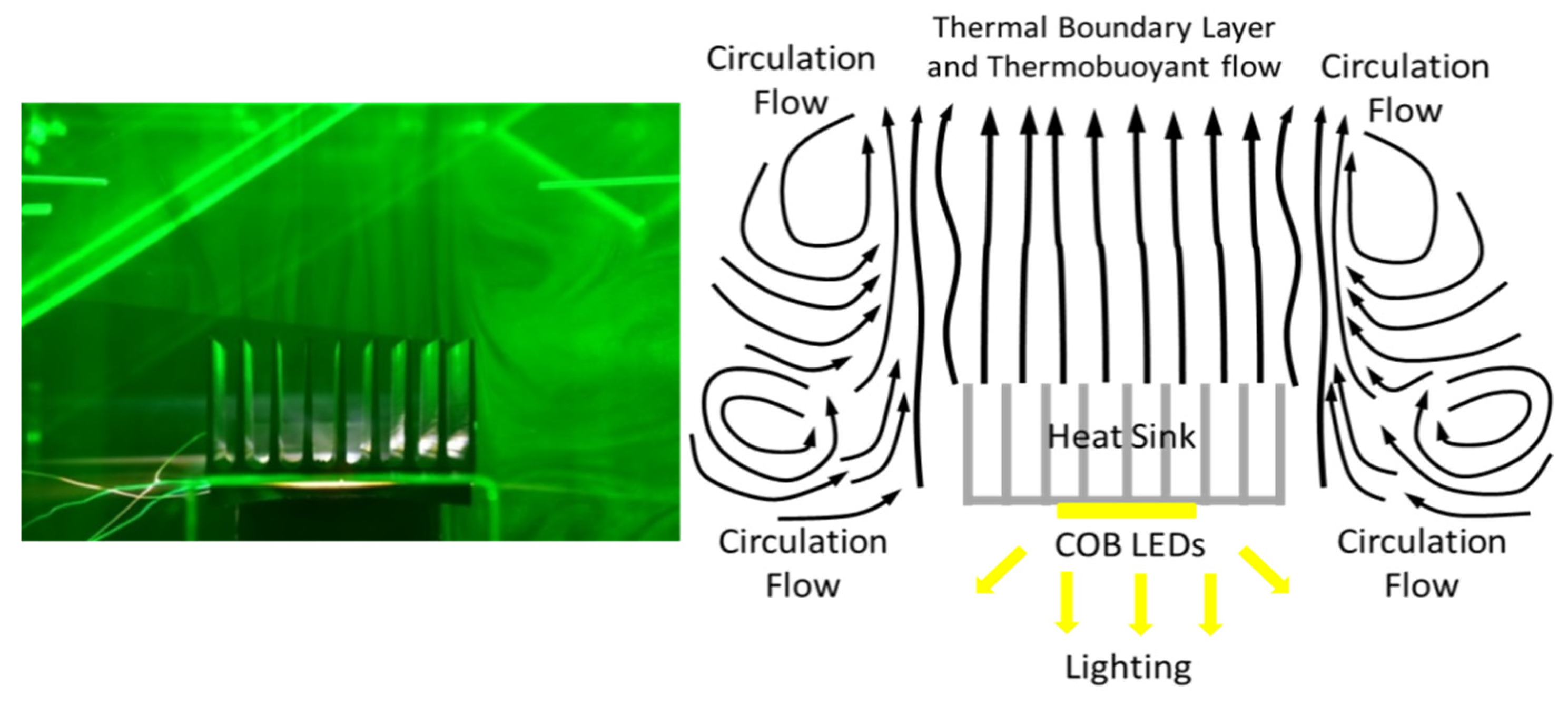

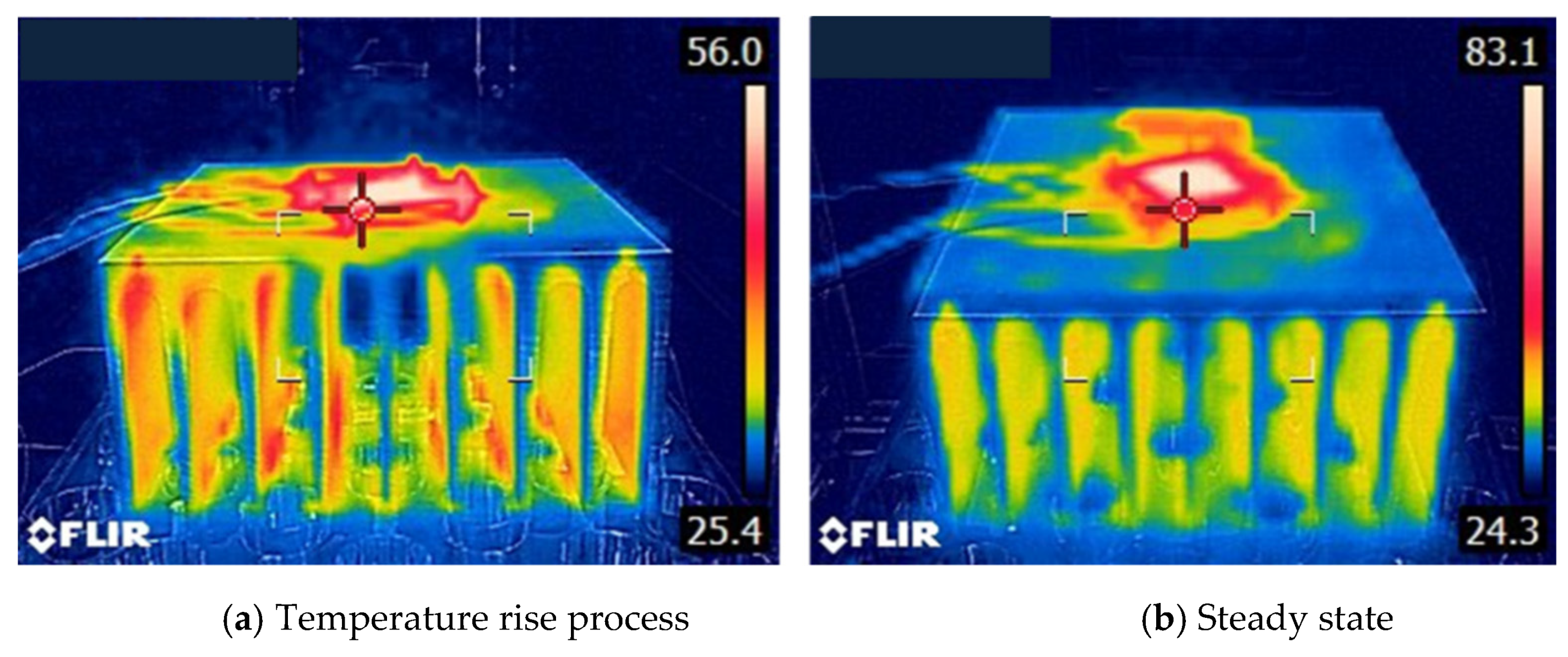
| Items | Specification | Photo Picture |
|---|---|---|
| Lens | Silicon/polymer | 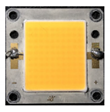 |
| Electrodes | Ag plating copper alloy | |
| Chip dimensions | Chip-on-board InGaN/GaN for third generation 40 × 40 × 1 mm3 | |
| Defined power | 50 W min and 100 W max | |
| DC current | 1560 mA and 3120 mA | |
| Forward voltage | 32 Vf | |
| Surface case temperature (Tcase) | <75 °C max | |
| Junction temperature (Tj) | <125 °C max | |
| Heat sink material | Extrusion aluminum AL 6069 L × W × H: 125 × 125 × 70 mm3 Heat conductivity coefficient: 180–200 W/m·K |  |
| Temperature ΔT (Tcase − Tf) | Graphene Thermal Grease (wt.%) | ||
|---|---|---|---|
| Time (s) | 10% | 15% | 20% |
| 0 | 0 °C | 0 °C | 0 °C |
| 400 | 13.50 | 11.06 | 13.12 |
| 800 | 14.10 | 12.10 | 14.02 |
| 2000 | 14.33 | 13.46 | 15.45 |
| 2800 | 14.59 | 13.97 | 15.90 |
| 3600 | 14.79 | 14.01 | 16.02 |
| 4400 | 15.20 | 14.10 | 16.04 |
| 5200 | 15.35 | 14.11 | 16.05 |
| 6000 | 15.57 | 14.11 | 16.05 |
| 6800 | 15.69 | 14.12 | 16.06 |
| 7600 | 15.69 | 14.12 | 16.06 |
| 8000 | 15.69 | 14.12 | 16.06 |
| Temperature Tcase | Graphene Thermal Grease (wt.%) | ||
|---|---|---|---|
| Time (s) | 10% | 15% | 20% |
| 0 | 25 °C | 25 °C | 25 °C |
| 400 | 49.21 | 46.51 | 49.08 |
| 800 | 59.77 | 57.06 | 59.92 |
| 2000 | 74.36 | 71.11 | 74.49 |
| 2800 | 77.59 | 74.37 | 77.85 |
| 3600 | 79.01 | 74.49 | 79.21 |
| 4400 | 79.02 | 74.69 | 79.30 |
| 5200 | 79.04 | 74.89 | 79.32 |
| 6000 | 79.08 | 75.01 | 79.36 |
| 6800 | 79.08 | 75.08 | 79.36 |
| 7600 | 79.08 | 75.13 | 79.36 |
| 8000 | 79.08 | 75.16 | 79.36 |
| Temperature Tj | Graphene Thermal Grease (wt.%) | ||
|---|---|---|---|
| Time (s) | 10% | 15% | 20% |
| 0 | 25 °C | 25 °C | 25 °C |
| 400 | 68.50 | 67.07 | 68.37 |
| 800 | 74.35 | 72.87 | 74.36 |
| 2000 | 82.15 | 80.44 | 82.12 |
| 2800 | 83.76 | 82.04 | 83.79 |
| 3600 | 84.07 | 82.10 | 84.38 |
| 4400 | 84.12 | 82.13 | 84.40 |
| 5200 | 84.14 | 82.23 | 84.42 |
| 6000 | 84.27 | 82.33 | 84.44 |
| 6800 | 84.39 | 82.33 | 84.44 |
| 7600 | 84.39 | 82.43 | 84.44 |
| 8000 | 84.39 | 82.43 | 84.44 |
| Temperature | Graphene Thermal Grease (wt.%) | ||
|---|---|---|---|
| Items | 10% | 15% | 20% |
| Tambient | 25–32.6 °C | 25–32 °C | 25–32.9 °C |
| Tcase | 79.1 °C | 75.2 °C | 79.4 °C |
| Tj | 84.4 °C | 82.4 °C | 84.4 °C |
Publisher’s Note: MDPI stays neutral with regard to jurisdictional claims in published maps and institutional affiliations. |
© 2021 by the authors. Licensee MDPI, Basel, Switzerland. This article is an open access article distributed under the terms and conditions of the Creative Commons Attribution (CC BY) license (https://creativecommons.org/licenses/by/4.0/).
Share and Cite
Hsu, C.-N.; Lee, K.-W.; Chen, C.-C. Using Graphene-Based Grease as a Heat Conduction Material for Hectowatt-Level LEDs: A Natural Convection Experiment. Processes 2021, 9, 847. https://doi.org/10.3390/pr9050847
Hsu C-N, Lee K-W, Chen C-C. Using Graphene-Based Grease as a Heat Conduction Material for Hectowatt-Level LEDs: A Natural Convection Experiment. Processes. 2021; 9(5):847. https://doi.org/10.3390/pr9050847
Chicago/Turabian StyleHsu, Chih-Neng, Keng-Wei Lee, and Chun-Chih Chen. 2021. "Using Graphene-Based Grease as a Heat Conduction Material for Hectowatt-Level LEDs: A Natural Convection Experiment" Processes 9, no. 5: 847. https://doi.org/10.3390/pr9050847
APA StyleHsu, C.-N., Lee, K.-W., & Chen, C.-C. (2021). Using Graphene-Based Grease as a Heat Conduction Material for Hectowatt-Level LEDs: A Natural Convection Experiment. Processes, 9(5), 847. https://doi.org/10.3390/pr9050847






